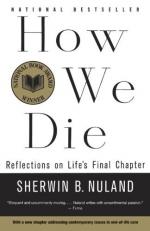
|
| Name: _________________________ | Period: ___________________ |
This test consists of 15 multiple choice questions and 5 short answer questions.
Multiple Choice Questions
1. What refers to a disease outbreak, which presents over a large area and is actively spreading?
(a) Trauma.
(b) Pandemic.
(c) Atria.
(d) Embolus.
2. Incidents of tuberculosis in AIDS patients are said to be how many times greater than non-AIDS related cases?
(a) 360.
(b) 500.
(c) 30.
(d) 140.
3. The author claims in the Epilogue that “good health is a guarantee of” what?
(a) “Body function.”
(b) “Long life.”
(c) “Easy life.”
(d) “Nothing.”
4. The medical etymology of the term cancer can be traced back to the days of whom, according to Dr. Nuland in Chapter 10?
(a) Hippocrates.
(b) Herodotus.
(c) Plato.
(d) Aristotle.
5. How much did Robert DeMatteis weigh, according to the author in Chapter 11?
(a) 185 lbs.
(b) 320 lbs.
(c) 245 lbs.
(d) 150 lbs.
6. In what year was Ishmael Garcia diagnosed with HIV?
(a) 1990.
(b) 1995.
(c) 1979.
(d) 1983.
7. What word from the Epilogue means caused by or evidencing a mentally disturbed condition?
(a) Psychological.
(b) Traumalogical.
(c) Philosophical.
(d) Pathological.
8. AIDS was first recognized by the Centers for Disease Control and Prevention in what year?
(a) 1981.
(b) 1990.
(c) 1975.
(d) 1986.
9. What is the protagonist’s profession in The Water-Babies, A Fairy Tale for a Land Baby?
(a) Miner.
(b) Chimney-sweep
(c) Rancher.
(d) Fisherman.
10. The author states that he is entering what decade in his life in the Epilogue?
(a) The eighth.
(b) The fifth.
(c) The sixth.
(d) The seventh.
11. What word in Chapter 7 refers to a condition of severely deficient supply of oxygen to the body that arises from being unable to breathe normally?
(a) Obtundation.
(b) Pandemic.
(c) Asphyxia.
(d) Dementia.
12. What profession did Robert DeMatteis have?
(a) Doctor.
(b) Schoolteacher.
(c) Attorney.
(d) Computer guru.
13. How tall was Robert DeMatteis?
(a) 5’8”.
(b) 6'3".
(c) 5’4”.
(d) 6'1".
14. What is the first of the three main stages of HIV?
(a) AIDS.
(b) Acute infection.
(c) Myocardial infarction.
(d) Clinical Latency.
15. The author claims in the Epilogue, “We live today in the era not of the art of dying, but of the art of” what?
(a) “Saving life.”
(b) “Taking life.”
(c) “Changing life.”
(d) “Living life.”
Short Answer Questions
1. What term from Chapter 7 refers to less than full mental capacity in a medical patient?
2. What is the title of Chapter 12?
3. How many children did Ishmael Garcia have?
4. Harold Bliss was the first documented case of death by what means?
5. Harold Bliss was how old when he died?
|
This section contains 365 words (approx. 2 pages at 300 words per page) |

|




